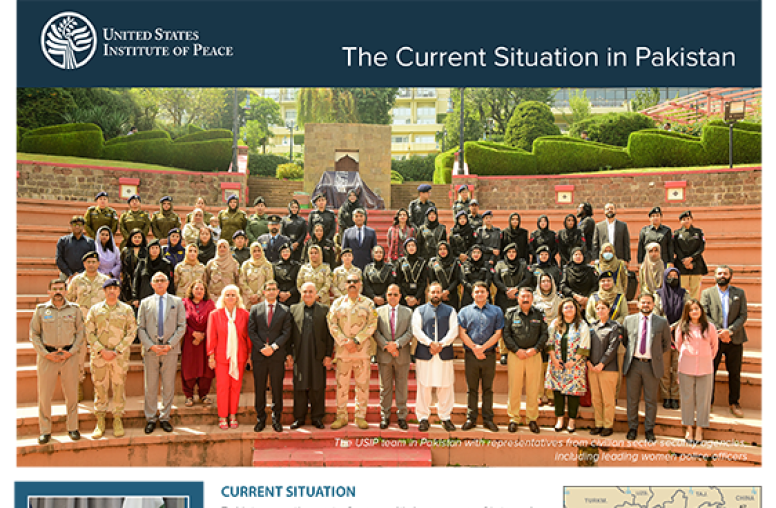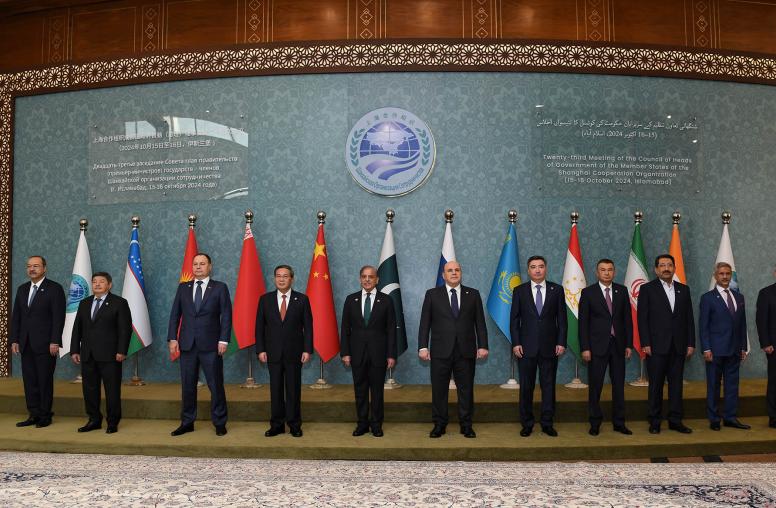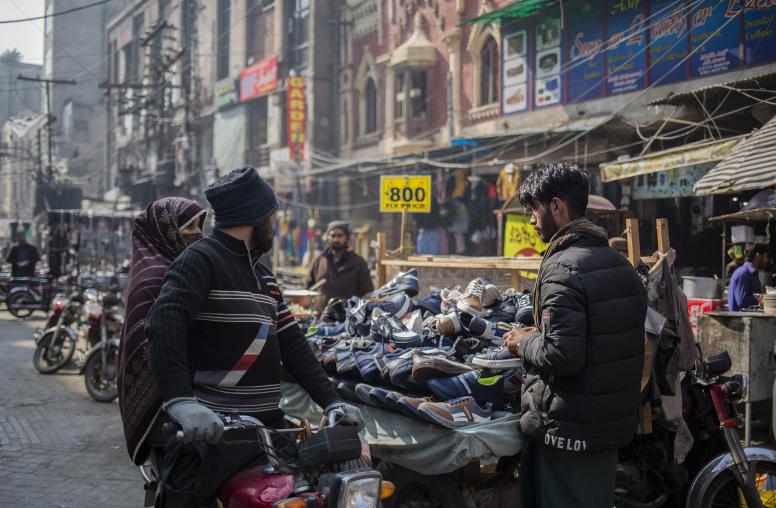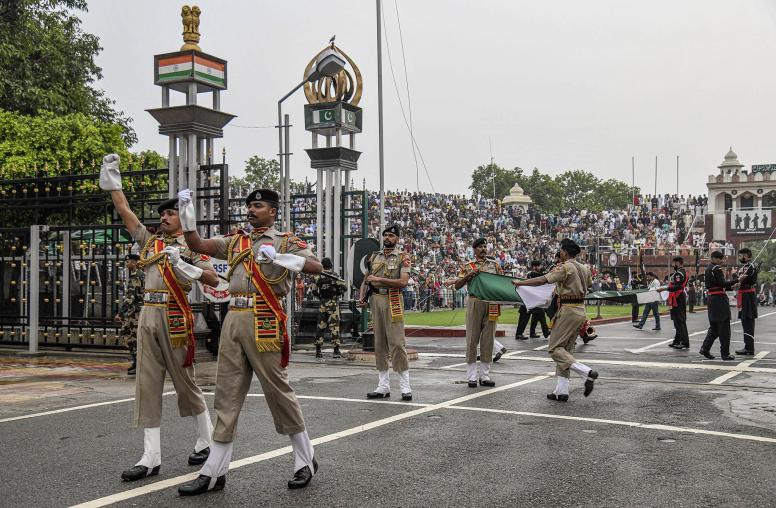Pakistan’s Resurgent Sectarian War
The violence across the Middle East has energized sectarian militant networks on both sides of the conflict in Pakistan. This report gives an overview of the history of conflict between Sunni Deobandi and Shia militant and political organizations in Pakistan and offers warnings about further radicalization there and its effects on the politics of the state.
Summary
- Sectarian violence between Sunni Deobandi and Shia Muslims in Pakistan has escalated in recent years. Most of this violence is perpetrated by local networks, but the sectarian phenomenon also has important ties to regional security dynamics and transnational terrorist networks.
- Despite sporadic state crackdowns, Pakistan’s leading Sunni Deobandi sectarian militant groups have been able to maintain a persistent presence thanks in part to reluctance among mainstream Pakistani military and political leaders to directly confront groups that are sometimes seen as serving utilitarian political interests.
- Due in part to this negligence, Sunni Deobandi militants have also established linkages with terrorist groups that target the Pakistani state, such as al-Qaeda and the Tehreek-e-Taliban Pakistan (TTP).
- Rising conflict in the greater Middle East over the past five years has strengthened the sectarian political narrative in Pakistan and emboldened sectarian militant networks on both sides of the conflict.
About this Brief
This report gives an overview of the history of sectarian conflict between Sunni Deobandi and Shia militant and political organizations in Pakistan, focusing on their indigenous roots and regional linkages. It draws upon material first published in a larger USIP-supported Middle East Institute study, Sunni Deobandi-Shi’i Violence in Pakistan, released in October 2014. Arif Rafiq is an adjunct scholar at the Middle East Institute and president of Vizier Consulting, LLC, which provides strategic guidance on Middle East and South Asian political and security issues.
Introduction
Sectarian violence between Sunni Deobandi and Shia Muslims in Pakistan has escalated in recent years, resulting in approximately 2,300 deaths in Pakistan’s four main provinces between 2007 and 2013 and at least 1,500 deaths in the Federally Administered Tribal Areas (FATA) agency of Kurram since 2007.1 Local networks perpetrate most of this violence, but the sectarian phenomenon also has important ties to regional security dynamics and transnational terrorist networks. Sunni Deobandi militants that first began organizing with the support of Pakistani security services in the 1970s and 1980s have directed their violence against Pakistan’s Shia minority, the Pakistani state, and the general populace.
The Birth of Sunni and Shia Sectarian Entrepreneurs
Initially founded as an inclusive Muslim-majority state, Pakistan’s sectarian tensions have deepened over the course of its history.2 Today’s militant sectarian actors in Pakistan trace their origins to internal and external political trends that began in the 1970s and early 1980s. During that time, General Muhammad Zia-ul-Haq’s campaign of Islamization alienated many Shias, who saw it as a majoritarian attempt to make the country more Sunni. At the same time, Iran was actively exporting its 1979 revolution to Shia communities outside Iran. By the mid-1980s, Iran-backed groups and clerics dominated religious Shia activism in Pakistan.3 The most notable of these groups was the Tehreek-e-Nifaz-e-Fiqh-e-Jafaria (TNFJ) led by Allama Arif ul Hussain Al-Hussaini, who demanded greater Shia autonomy within the country’s legal system and endorsed the leadership of Ayatollah Ruhollah Khomeini.4
Fearful of Iranian encroachment, General Zia found an ally5 in the Sipah-e Sahaba Pakistan (SSP), a Sunni Deobandi group founded in 1985 by Maulana Haq Nawaz Jhangvi, who was then a member of the Jamiat Ulema-e Islam party. Based in the Jhang district of Punjab, whose rural area is dominated by Shia landlords, Maulana Jhangvi positioned himself as a player in the sectarian wars regionally and nationally, engaging in both anti-Shia and anti-Iran rhetoric.
From the Fringe to the Mainstream
Allama al-Hussaini and Maulana Jhangvi were assassinated in separate attacks in 1988 and 1990, planting the seeds for targeted killings of other leaders and the emergence of structured Sunni Deobandi–Shia sectarian violence. The SSP, which now operates under the name Ahl-e Sunnat Wal Jamaat (ASWJ), grew throughout the 1990s, leaving an indelible mark on the politics and political economy of Punjab and the broader nation.6 Lashkar-e Jhangvi (LeJ) and Sipah-e Muhammad Pakistan (SMP), offshoots of the SSP and TNFJ, respectively, unleashed a brutal wave of violence in Punjab and Karachi in the 1990s, ultimately precipitating a crackdown by the Pakistan Muslim League government in Punjab from 1998–99.7
The crackdown’s long-term effects were limited; the ASWJ continues to operate openly despite a nominal ban and LeJ and Shia militant groups remain active. In Pakistan’s four provinces, Shia militants have targeted SSP/ASWJ members and sympathizers, as well as Sunni Deobandi clerics and religious students. The LeJ’s violence is far more prolific and indiscriminate than that of Shia militants. It has carried out repeated attacks with mass casualties, targeting Shia pilgrims and residential communities.
Despite sporadic crackdowns, the SSP/ASWJ partly owes its continued resilience to the Faustian bargains Pakistan’s civilian and military leaders have made with it. Although in many cases the alli-ances appear to be initiated at the local level, outside of the control of party leaders, the ruling Pakistan Muslim League-Nawaz (PML-N) party has at times entered into unofficial partnerships with the SSP/ASWJ, motivated by both electoral considerations and a desire to keep Punjab free of militant violence. Former PML-N Punjab law minister Rana Sanaullah admitted in 2010 that he met the SSP/ASWJ chief “twice to secure votes for the upcoming by-elections.”8 The PML-N is not unique is this regard. A number of politicians from the Pakistan Peoples Party (PPP) have also sought an ASWJ endorsement in recent elections, in part to deny the PML-N an opportunity to partner with the SSP.9 In 1993, the SSP joined the Punjab provincial government, led by the PPP; Sheikh Hakim Ali, a senior SSP leader, served in the PPP’s Punjab provincial cabinet “despite having eight murder cases registered against him.”10
LeJ Fuses with Al-Qaeda and the Pakistani Taliban
Even as Pakistan’s Deobandi Sunni sectarian groups have worked to enter the political mainstream—the ASWJ now positions itself as a political party and fielded at least forty candidates in the 2013 general elections—they have also developed ties to antistate terrorist organizations.11 The SSP/ASWJ forged initial training linkages with al-Qaeda in the 1980s. The bonds grew deeper during the 1990s, when the LeJ operated from a safe haven in Afghanistan from which it planned attacks in Pakistan. Since the September 11 attacks, LeJ has strengthened its partnerships with al-Qaeda and the TTP, supplying both groups with high-level, dual-hatted operatives, such as Qari Mohammad Zafar and Qari Hussain Mehsud.12 Many LeJ operatives, including Zafar—who was killed in a 2010 drone attack—fled to the FATA as al-Qaeda and similar groups faced a stiff crackdown in urban areas.
In FATA, LeJ operatives have evolved far beyond sectarian motives and opportunistic alliances. Zafar’s successor, Abu Zar Azzam, has become an outspoken jihadist preacher, calling for all-out war with the Pakistani state in audio and video releases.13 Like Qari Hussain Mehsud, Azzam was educated at Karachi’s Jamia Farooqia madrasah. LeJ fighters took part in major complex attacks in Punjab between 2007 and 2011, including a 2009 attack on the Sri Lankan cricket team.
The Resurgence of Sectarian Violence amid a Regional War
Rising conflict in the greater Middle East over the past five years has strengthened the sectarian political narrative in Pakistan and emboldened militant networks. Prime Minister Nawaz Sharif has close political ties to Saudi Arabia. In March, Riyadh provided Islamabad with $1.5 billion in aid. Pakistani officials initially sought to obscure the source of the donation.14 Several Shia activists the author spoke with believe that Islamabad is sending Sunni fighters to Syria.15 These allegations of direct governmental support for fighters have not been substantiated, but other analyses based on press reporting on foreign fighter presence suggest the number of Pakistani Shia fighters in Syria fighting on behalf of the al-Assad regime may be roughly comparable to the number of Pakistani Sunnis fighting against it.16
While the Pakistani state is tilting toward the Gulf Arab Sunni camp, Pakistan-based militants are increasingly setting their eyes on Iran. In January, a TTP commander called on anti-Shia sectarian activists to join his group and kill the Shia “before they are able to flee to Iran.” In February, a TTP splinter group launched the network’s first attack on an Iranian installation inside Pakistan, targeting Tehran’s consulate in Peshawar.17 In the same month, Jaish al-Adl, an Iranian Sunni Baloch insurgent group based in Pakistan, kidnapped Iranian border guards, prompting threats of reprisal strikes by Tehran.18
Iran is currently believed to play a limited though significant role in Pakistan’s sectarian war. It was allegedly involved in the killing of a Saudi intelligence officer in Karachi in May 2011.19 Karachi police officials also claim that Shia militants in the city receive training and refuge in Iran.20 And Tehran may be backing a new Shia political party, the Majlis Wahdat-e Muslimeen (MWM).21 The MWM appears less inclined to follow the Hezbollah model and more inclined to follow the peaceful approach of Bahrain’s Al-Wefaq.22 But there are indications the party is involved in some violence: Police officials interviewed in both Karachi and Quetta linked the party to some killings of Sunni Deobandis.
Conclusions
Sunni Deobandi-Shia sectarian violence is an enduring problem in Pakistan as it is intimately linked to the broader, pervasive phenomenon of Deobandi militancy. According to a former senior Pakistani federal law enforcement official, when Deobandi militant groups seek to keep their rank and file “active,” their “natural fallback position is sectarian.” 23 Foreign actors and regional conflicts have and will continue to exacerbate sectarian tensions in Pakistan. But sectarianism in Pakistan is not dependent on external influences. It has become an established industry with entrepreneurs abetted or patron-ized by a broad segment of power brokers inside Pakistan. Until it is dealt with structurally, Sunni Deobandi–Shia sectarian violence will continue. Pakistan is unlikely to see Iraq-style sectarian violence that existentially threatens the country. But the continuation of sectarian bloodshed, along with the mainstreaming of purveyors of sectarian hatred, will further radicalize elements in both Sunni Deobandi and Shia communities and consolidate Pakistan’s transition toward an ugly majoritarian state.
Notes
- Author database comprised of reports from the Daily Times, Dawn, Express Tribune, and The News.
- Although Pakistan’s founder, Muhammad Ali Jinnah, was a Shia Muslim, sectarian entrepreneurship preceded the emergence of contemporary Sunni Deobandi–Shia feuds. Since the 1950s, mainline Sunni groups in Pakistan, as well as some Shia clerics, have pressed for members of the Ahmadiyya sect to be declared non-Muslims under the constitution. They achieved their goal in 1974.
- While Pakistani Shia parties have been pro-Iran since the 1980s, Pakistani Shias generally do not vote for religious parties in elections. They tend to support secular parties, such as the Muttahida Qaumi Movement and Pakistan Peoples Party, which are generally seen as pro-Shia.
- Al-Hussaini called for ittihad bainul muslimeen, or unity between [Sunni and Shia] Muslims. But he was also prone to incendiary rhetoric against the government. In 1987, he warned: “Shias will topple the government in Islamabad if it helps the United States to launch anti-Iran opera-tions from Pakistan.” See Jonathan Broder, “Sectarian Strife Threatens Pakistan’s Fragile Society,” Chicago Tribune, November 10, 1987, available at articles.chicagotribune.com/1987-11-10/news/8703240490_1_shiites-sunni-karachi (accessed October 24, 2014).
- Testimony of Tariq Khosa, former director general of the Federal Investigation Agency, before the Senate Committee on Defense and Defense Production, September 28, 2012, available at www.senate.gov.pk/uploads/documents/1365092265_822.pdf (accessed October 24, 2014).
- Ayesha Siddiqa, “The New Frontiers: Militancy and Radicalism in Punjab,” SISA Report no. 2, Centre for International and Strategic Analysis, Oslo, 2013, available at strategiskanalyse.no/publikasjoner%202013/2013-02-04_SISA2_The_New_Frontiers_-_Ayesha_Siddiqa.pdf (accessed October 24, 2014).
- Hassan Abbas, Pakistan’s Drift Into Extremism: Allah, the Army, and America’s War on Terror (Armonk, NY: M.E. Sharpe, 2005), 209.
- Hussain Kashif, “Administrators’ Appointment on Non-Political Basis: Sanaullah,” Daily Times, Februrary 24, 2010, available at archives.dailytimes.com.pk/lahore/24-Feb-2010/administrators-appointment-on-non-political-basis-sanaullah (accessed October 24, 2014).
- Salaar Abbasi, “Sleeping with the Enemy,” The News, May 8, 2013, available at www.thenews.com.pk/Todays-News-16-176147-Sleeping-with-the-enemy (accessed October 24, 2014).
- Vali Nasr, “Islam, the State, and the Rise of Sectarian Militancy in Pakistan,” in Pakistan: Nationalism without a Nation, ed. Christopher Jaffrelot, (New York: Zed Books, 2002), 104.
- Abbasi, “Sleeping.”
- M. Ilyas Khan, “Formidable Power of Pakistan’s Anti-Shia Militants,” BBC News, January 12, 2013, available at www.bbc.co.uk/news/world-asia-20983153 (accessed October 24, 2014).
- “Missile ‘Kills Lashkar-e-Jhangvi Leader’ in Pakistan,” BBC News, March 2, 2010, available at news.bbc.co.uk/1/hi/world/south_asia/8544744.stm (accessed October 24, 2014).
- Mehreen Zahra-Malik, “Saudi Arabia Loans Pakistan $1.5 Billion to Shore Up Economy,” Reuters, March 13, 2014, available at www.reuters.com/article/2014/03/13/us-pakistan-saudi-idUSB-REA2C13G20140313 (accessed October 24, 2014).
- Interviews with Shia activists in Abbas Town, Karachi.
- “Shi’ite Foreign Fighters in Syria,” The Meir Amit Intelligence and Terrorism Information Center, Ramat Hasharon, Israel, available at www.terrorism-info.org.il/Data/articles/ Art_20631/E_025_14_146498974.pdf (accessed October 24, 2014); Aaron Y. Zelin, “Up to 11,000 Foreign Fighters in Syria; Steep Rise among Western Europeans,” op-ed, Washington Institute, December 17, 2013, available at www.washingtoninstitute.org/policy-analysis/view/up-to-11000-foreign-fighters-in-syria-steep-rise-among-western-europeans (accessed October 24, 2014).
- “Suicide Attack at Iranian Consulate in Peshawar Kills Two,” Dawn, February 24, 2014, available at www.dawn.com/news/1089170 (accessed October 24, 2014).
- Katharine Houreld, “Pakistan Warns Iran Not to Send in Troops after Guards Kidnapped,” Reuters, February 18, 2014, available at www.reuters.com/article/2014/02/18/us-iran-pakistan-kidnapping-idUSBREA1H11V20140218 (accessed October 24, 2014).
- David Ignatius, “Intelligence Links Iran to Saudi Diplomat’s Murder,” Washington Post, October 13, 2011, available at www.washingtonpost.com/blogs/post-partisan/post/intelligence-links-iran-to-saudi-diplomats-murder/2011/10/13/gIQAFzCPiL_blog.html (accessed October 24, 2014).
- Tariq Habib, “200 Iranian-Trained Sipah-e-Muhammad Activists Hunting Down ASWJ Work-ers,” Pakistan Today, May 26, 2011, available at www.pakistantoday.com.pk/2011/05/26/city/karachi/%E2%80%98200-iranian-trained-sipah-e-muhammad-activists-hunting-down-aswj-workers%E2%80%99/ (accessed October 24, 2014).
- There is no direct evidence of Iranian support for MWM. But the party maintains an office in Qom, Iran. Its leaders have met with Ayatollah Khamenei, the Supreme Leader of the Islamic Republic of Iran; Gholam-Ali Haddad-Adel, an aide to Khamenei; and Hassan Nasrallah, the Hezbollah chief. See MWM Pakistan Twitter, available at twitter.com/mwmpakofficial/status/439006080975527936 (accessed October 24, 2014), and Jaferia News Network Twitter, available at twitter.com/JNNsms/status/429508532027662336 (accessed October 24, 2014). The MWM website also publishes Urdu translations of Khamenei’s speeches; see videos.mwmpak.org/view_video.php?viewkey=604370953 (accessed October 24, 2014).
- The Al-Wefaq National Islamic Society is a cleric-led Shia political party in Bahrain. It participates in the electoral process and is relatively moderate, despite unsubstantiated accusations by Manama that it receives support from Hezbollah. See Jay Solomon, “Bahrain Sees Hezbollah Plot in Protest,” Wall Street Journal, April 25, 2011, available at online.wsj.com/news/articles/SB1000142405274870 3907004576279121469543918?mg=reno64-wsj (accessed October 24, 2014).
- Interview with former senior federal law enforcement official.



